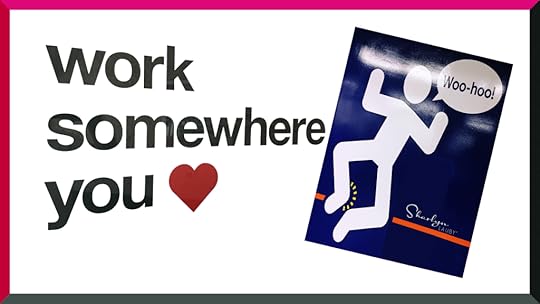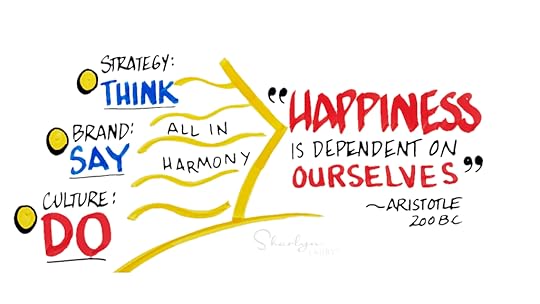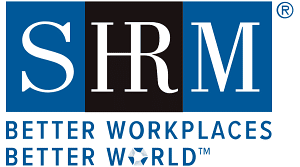Sharlyn J. Lauby's Blog, page 15
November 19, 2024
10 Things to Include in Your Artificial Intelligence Policy

Estimated reading time: 4 minutes
We’ve been chatting lately about the need for organizations to have artificial intelligence (AI) policies. I recently interviewed my friend and attorney Carrie Cherveny about some of the things that organizations might want to consider including in their policy. I hope you’ll check it out.
In the interview with Carrie, not only does she share her knowledge, but she shared the results of an AI inquiry. What does AI say should be in an AI policy? I want to elaborate on this today by sharing what a couple other AI platforms say should be included in an artificial intelligence policy.
I’ve said before that all artificial intelligence tools are not the same, so I asked ChatGPT4o, which was developed by OpenAI, and Gemini, which was developed by Google. Surprisingly, there were many similarities in their responses. Here are the ten things that they agree should be included in an organization’s artificial intelligence policy.
I was very encouraged that ChatGPT4o and Gemini agreed about the considerations for an artificial intelligence policy. Oh sure, they use some different words like ChatGPT called #6 above “employee rights” and Gemini said, “human oversight”, but the content was very much the same.
When we think about activities like pre-employment assessments, we ask ourselves “Are the results valid and reliable?” Valid meaning that the assessment did what it was supposed to do. Reliable meaning that the results would be basically the same if asked again. While this was a totally non-scientific experiment for me, I was pleased to see that the results were related to the question asked (valid) and that multiple artificial intelligence tools are coming to the same conclusions (reliable).
If organizations haven’t already done so, now is the time to start thinking about an AI policy. And if you have one – great! Remember to regularly review and revise it. Artificial intelligence isn’t going away. Organizations today need to have an opinion about how they will use it.
Image captured by Sharlyn Lauby while exploring the streets of Lake Buena Vista, FL
The post 10 Things to Include in Your Artificial Intelligence Policy appeared first on hr bartender.
November 17, 2024
New Hire Buddy Programs: How to Evaluate Your Success [Part 4]

Estimated reading time: 4 minutes
There’s a reason that new hire buddy programs are popular. According to Gallup, employees who have a friend or buddy at work are seven times more likely to be engaged in their jobs, are better at engaging customers, produce higher quality work, have higher wellbeing, and are less likely to get injured on the job.
While the research supports having a buddy program, it doesn’t mean that companies shouldn’t evaluate the program’s success. Just because a program exists doesn’t mean that all parts of the program are running smoothly. Especially when it comes to buddy programs, which have multiple stakeholders. In fact, that could be one approach to evaluating the program – check in with the four key stakeholders to confirm that program goals and objectives are being met.
New hire employees. More than 28% of Americans are looking for new jobs, according to an article from NBC News. The last thing companies want is to spend a lot of time and resources hiring someone only to have them leave within the first year.
Check in with new hires to make sure they feel the buddy program is helpful. Organizations can create 1-2 question pulse surveys to collect data and benchmark results. They can also conduct focus groups with new hires to collect stories about how the program is working.
Hiring manager. A primary goal of creating an onboarding buddy program is productivity. The faster employees become engaged, the more productive they become. There’s a strong chance that the hiring manager is going to select the buddy, so they will be looking for feedback about how the buddy relationship is working.
Initially, it could be challenging to receive direct feedback from new hires and buddies about how the relationship is progressing. Electronic surveys could be a great way to start collecting information. Once trust has been established, managers can use one-on-one meetings to get more details.
The buddy. Just a reminder that the buddy isn’t the new hire’s supervisor and they’re not a substitute for training. That being said, the buddy does have a role, and they should be given the opportunity to share feedback with HR, the hiring manager, and maybe even the new hire.
The other aspect of the buddy role to consider is the buddy’s performance. Organizations are going to select a buddy who is a high-performer. No one wants a new hire learning bad habits. Do buddies view their role of helping new hires as recognition? Does having a buddy program lift company performance as a result?
Human resources. Buddy programs do add a few extra steps for HR in terms of making sure that buddies have been assigned, roles clarified, and the program explained during orientation. But conducting the pulse surveys or focus groups (mentioned above) shouldn’t be an administrative burden. Hopefully, surveying employees is already taking place in some form and this is just an extension of those efforts.
If the research supporting buddy programs is correct, HR should see a reduction in turnover. Better onboarding and more engagement leads to greater retention. It should also help with cost per hire. Lower turnover means less hiring (and fewer hiring expenses).
Measuring the results of your onboarding buddy program doesn’t have to be difficult or complex. But, it does need to happen. Checking in with the key stakeholders allows organizations to make sure that everyone involved in the program is seeing the results they need. And using a combination of quantitative and qualitative methods translates into feedback that all groups will find valuable.
Image captured by Sharlyn Lauby while grabbing a bubble tea at Kung Fu Tea in Gainesville, FL
The post New Hire Buddy Programs: How to Evaluate Your Success [Part 4] appeared first on hr bartender.
New Hire Buddy Programs: How to Evaluate Your Success

Estimated reading time: 4 minutes
There’s a reason that new hire buddy programs are popular. According to Gallup, employees who have a friend or buddy at work are seven times more likely to be engaged in their jobs, are better at engaging customers, produce higher quality work, have higher wellbeing, and are less likely to get injured on the job.
While the research supports having a buddy program, it doesn’t mean that companies shouldn’t evaluate the program’s success. Just because a program exists doesn’t mean that all parts of the program are running smoothly. Especially when it comes to buddy programs, which have multiple stakeholders. In fact, that could be one approach to evaluating the program – check in with the four key stakeholders to confirm that program goals and objectives are being met.
New hire employees. More than 28% of Americans are looking for new jobs, according to an article from NBC News. The last thing companies want is to spend a lot of time and resources hiring someone only to have them leave within the first year.
Check in with new hires to make sure they feel the buddy program is helpful. Organizations can create 1-2 question pulse surveys to collect data and benchmark results. They can also conduct focus groups with new hires to collect stories about how the program is working.
Hiring manager. A primary goal of creating an onboarding buddy program is productivity. The faster employees become engaged, the more productive they become. There’s a strong chance that the hiring manager is going to select the buddy, so they will be looking for feedback about how the buddy relationship is working.
Initially, it could be challenging to receive direct feedback from new hires and buddies about how the relationship is progressing. Electronic surveys could be a great way to start collecting information. Once trust has been established, managers can use one-on-one meetings to get more details.
The buddy. Just a reminder that the buddy isn’t the new hire’s supervisor and they’re not a substitute for training. That being said, the buddy does have a role, and they should be given the opportunity to share feedback with HR, the hiring manager, and maybe even the new hire.
The other aspect of the buddy role to consider is the buddy’s performance. Organizations are going to select a buddy who is a high-performer. No one wants a new hire learning bad habits. Do buddies view their role of helping new hires as recognition? Does having a buddy program lift company performance as a result?
Human resources. Buddy programs do add a few extra steps for HR in terms of making sure that buddies have been assigned, roles clarified, and the program explained during orientation. But conducting the pulse surveys or focus groups (mentioned above) shouldn’t be an administrative burden. Hopefully, surveying employees is already taking place in some form and this is just an extension of those efforts.
If the research supporting buddy programs is correct, HR should see a reduction in turnover. Better onboarding and more engagement leads to greater retention. It should also help with cost per hire. Lower turnover means less hiring (and fewer hiring expenses).
Measuring the results of your onboarding buddy program doesn’t have to be difficult or complex. But, it does need to happen. Checking in with the key stakeholders allows organizations to make sure that everyone involved in the program is seeing the results they need. And using a combination of quantitative and qualitative methods translates into feedback that all groups will find valuable.
Image captured by Sharlyn Lauby while grabbing a bubble tea at Kung Fu Tea in Gainesville, FL
The post New Hire Buddy Programs: How to Evaluate Your Success appeared first on hr bartender.
November 14, 2024
7 Tips for Having a Good Day at Work

Estimated reading time: 4 minutes
New research from UKG indicates that 75% of frontline workers are feeling overworked and underpaid. The research also indicates that the number rises to 83% of Gen Z workers in the same sector. I realize that organizations are very focused on the bottom-line. Frankly, they always are. Putting profits over people is not a winning strategy.
But that’s not the focus of today’s article. The research got me thinking … what does it take to have a good day at work? Yes, obviously we need to feel like we’re being paid fairly, and we need to feel like our workload is manageable. Sometimes even when we have those things, we can have not-so-great days at work.
Recently, I listened to Caroline Webb’s LinkedIn Learning course titled “How to Have a Great Day at Work” and wanted to share my takeaways. Webb is an executive coach and author of the best-selling book “How to Have a Good Day”. As a reminder, if you do not have a LinkedIn Learning account, it’s possible your local library has a partnership with LinkedIn, and you can access this course for FREE with a library card.
In the course, Webb talks about our brains and how when are brains are tired this can impact our ability to get things done. That leads to crankiness and well, not having a good day. So, my first takeaway was if you’re not having a good day, maybe you need to ask yourself “Why?”. Can you isolate the reason? It could be a project you’re working on, and you’re stuck. Or a co-worker that’s annoying. Or maybe something at home.
Think about if it makes sense to have some sort of “work mood tracker” that might help to identify those things that are keeping you from having a good day at work. Because once you know those reasons, then you can work on resolving them. Webb mentions several activities that individuals can do to help create better days at work including:
Writing things down. Instead of trying to remember everything, write down your to-do’s. Then prioritize them. Once it’s on a list, then let it go until you can get to it.Learn how to plan. Regular readers of HR Bartender know I’m a planner. Planning can help to maintain focus on priorities and not worry about all the other stuff (because it’s on your list and will get taken care of when it’s time).Start small and make progress easy. This is kinda related to writing things down and planning (#1 and #2). Take big projects and break them down into small parts so they aren’t quite as overwhelming.Include “me” time on your calendar. Yes, we need to be productive and get things done. We also need to take time to relax and recharge. Find time for yourself. It will only help your productivity.Reduce multi-tasking. Webb talks about how multi-tasking can make our brains tired and keep us from doing our best work (and not having a good day). I don’t want to tell anyone to eliminate multi-tasking … not sure if that’s completely realistic. But do see if there are ways to reduce it so your brain stays active.Make it fun and celebrate your successes. Crossing something off your to-do list can be incredibly gratifying. Take a moment to enjoy it.End the day on a high note. One of the things that can contribute to a less than great day is ending the day when we’re tired or angry or frustrated. Webb explains how that feeling might stay with us and suggests finding time to wrap up the day with “me” time – maybe it’s doing something fun or taking a moment to do some gratitude journaling. Whatever it is, see if ending the day in a more peaceful way helps.My takeaway from this course was that the key to having a good day is to do activities that keep my brain active. When my brain gets tired, then I get tired and that keeps me from having a good day. Sure, there will be days when I will have frustrating moments. But being conscious of that – and finding ways to offset it – maybe by stepping away from my desk – help me to get back on track. And back on track for having a good day at work.
Image captured by Sharlyn Lauby while exploring the streets of Fort Lauderdale, FL
The post 7 Tips for Having a Good Day at Work appeared first on hr bartender.
November 12, 2024
The Value of Compliance Subscription Services

Estimated reading time: 5 minutes
(Editor’s Note: Today’s article is brought to you by our friends at ComplyRight , whose mission is to free employers from the burden of tracking and complying with the complex web of federal, state, and local employment laws, so you can stay focused on managing and growing the business. Enjoy the article!)
Over the past few years, you’ve probably noticed an increase in subscription services. Subscription services can be good for customers because they get the products and/or services they need on a regular basis. Subscriptions bring real value because they require little, or no effort once initiated.
For the businesses that offer them, a subscription model is beneficial because they can provide a scalable product or service to customers at a reasonable price. The reason I wanted to talk about subscription services is because there are financial articles that will suggest all subscription programs are bad or wrong. That’s simply not true. There are many subscription services that easily provide a positive return on investment (ROI).
An example of a valuable subscription service that we use in our personal lives is credit monitoring. These services inform us of changes or alerts in areas that might damage our credit. This type of service has been in the media a lot recently with the news that there was a data breach exposing the social security numbers of millions of Americans.
Here are three examples of business-related subscription services that provide value to our organizations.
This is an annual compliance service that allows organizations to stay current with employment related legislation at the federal, state, county, and city level. ComplyRight’s expert legal team monitors legislative activity around the United States including over 20,000 agencies. The type of activity being monitored includes minimum wage, salary history, discrimination, harassment, sick pay, leaves, safety, and more.
When there’s a change, you receive an email alert with a summary of the law (in plain language) and some action items for implementing the new requirements. Subscribers will also have access to a database of recent alerts.
Like the employment law alert service, this is an annual subscription that allows organizations to stay current with labor law posting requirements. If the organization is changing labor law posters once a year, that might not be enough to stay in compliance. There are on average more than 200 mandatory state, city, and county employment law changes every year that require an immediate poster update or replacement.
The ComplyRight legal team monitors 175 different government agencies that are responsible for over 500 mandatory employment law posters. And when a change happens, you’ll get a replacement poster … for FREE!
In addition to labor law posters, there are some required legal notifications that employers must provide. There are more than 400 different federal and state notices that employers must distribute. Some of these are distributed during orientation, but others are “event driven” like a notification for Family and Medical Leave.
With this service, organizations are provided with electronic access to federal, state, county, and city handouts so they can be printed and delivered to employees. And like the other subscriptions I’ve mentioned, the expert legal team at ComplyRight monitors the files so you will have the most current information when you need it.
Now, some people might be saying, “Yea, this is great, but I can do all this research myself.” And you’re right … you can. The question becomes what’s the expense of doing it all yourself? In an Austin Business Journal article, they reported that 44% of small business owners spend 40+ hours a year on federal regulations and 33% spend more than 80. Keep in mind those are only federal regulations, not state / county / city.
Eighty (80) hours is a lot of time. It’s time that could be spent on recruiting, training, and retaining employees. It’s time that you could spend on your own professional development. It’s time you wouldn’t have to spend working late or on a weekend. You get the point. HR’s time is valuable. Your time is valuable.
Now let’s talk in terms of dollars. According to Indeed, the average HR manager’s salary is $83,000/annually. That’s $39.90/hour. I’m not here to debate whether Indeed’s numbers are accurate. Let’s just say they are. If we multiply the hourly rate by 80 hours (of time spent on compliance), then we spend $3192 annually just on compliance research.
A subscription service is a fraction of that cost. And those subscription services are being monitored by legal professionals. This becomes a very cost-effective way to get mandatory legal updates and information.

I’ve mentioned before that one of the first things that I had to learn as a consultant was just because I coulddo something it didn’t mean I should. Because I could be using my time on the wrong things. I had a boss once who like to say it was “stepping over dollars to pick up quarters”.
Organizations definitely need to watch their budgets and spend wisely. They should regularly evaluate their expenses and make sure they are delivering value. Mr. Bartender and I do it all the time in both our personal and professional lives.
So, don’t immediately dismiss subscription services just because … well, that’s what they are. Make sure you know how they work and are making the most of what they provide. The services they offer can free up time to create more value.
P.S. As you’re working on budgets for next year, be sure to check out ComplyRight’s subscription services mentioned in this article. If you’re following the news, then you know that 2025 could be an action-packed year in terms of labor and employment compliance. It might be perfect to have a partner that can help the organization navigate changes.
The post The Value of Compliance Subscription Services appeared first on hr bartender.
November 10, 2024
10 Ways Organizations Can Support Employee Self Care

Estimated reading time: 4 minutes
Self-care is defined as taking the time to do things that help us live well and improve both our physical and mental health. In theory, when we say that we “taking care of ourselves”, we’re practicing self-care. The challenge with self-care is identifying the best ways to do that, meaning care for ourselves.
Now, some of you might be saying, “I appreciate the need for self-care. But what does this have to do with employees and the workplace?” The answer is … a lot. Employee self-care has really come into focus in recent years. We know that it’s hard for employees to be engaged and productive if they’re not healthy. Disengagement and a lack of productivity impact the bottom-line.
Even if the company doesn’t have a formal wellness or wellbeing program, it makes sense for employers to support the idea of self-care. Here are a ten things companies can do to support employee self-care without spending extra money or creating a program.
Make ergonomics a priority. This is especially important with all the discussion around return to the officeBONUS: Here’s one more. Number 11 – demonstrate effective use of technology. It might be tempting to say that tech is the reason more people can’t focus on self-care. But that’s not always true. There are many apps on the market that can make self-care effective and fun. Organizations need to set realistic expectations where technology is concerned. Managers should role model the tech etiquette they want to see from others.
Companies looking to improve engagement and retention need to examine the ways they support employee self-care. And employees need opportunities to relax and recharge in order to do their best work.
Image captured by Sharlyn Lauby after speaking at the SHRM Annual Conference in Las Vegas, NV
The post 10 Ways Organizations Can Support Employee Self Care appeared first on hr bartender.
November 7, 2024
The 4 Phases of an Offboarding Program

Estimated reading time: 4 minutes
I’ve published a couple of articles lately about the relationship between onboarding and offboarding. We spend a lot of time talking about the value of onboarding. It sets the stage for the new employee’s career with the organization. Onboarding is an opportunity to demonstrate that the organization cares about the employee and is planning to make the investments necessary for the employee to be successful.
On some level, offboarding can do the same thing. Granted, offboarding is focused on an employee’s departure from the organization. But the way people leave the company can have a profound impact on how they speak about the company in the future. Designing a strategic offboarding process can let employees know we appreciate their time and contributions. It can send the message to current employees that we treat people with respect, even when they’re leaving.
To design a strategic offboarding process, organizations might want to consider using a process map. Similar to an onboarding process map, this document would outline what should take place during the traditional offboarding process. It could be used for both departing employees as well as freelancers and/or contractors. Consider outlining the individual steps into four parts or phases:
Awareness: This is the place where the organization learns that the employee (or freelancer) is leaving. When we talk about offboarding, we’re talking about both voluntary as well as involuntary departures. Some of the steps could be different with an involuntary termination, but many will be the same. Preparation: During this phase, the organization and employee are working together to wrap up projects, etc. Given today’s labor market, there’s a very good chance that an employee will leave, and their replacement will not yet be hired. The employee and their manager will want to evaluate current workload and transition projects to other individuals on the team. Engagement: Organizations have an opportunity to solicit feedback from the employee. Before the employee leaves, the hiring manager or human resources might want to talk with the employee about their time with the company. This could be considered an exit interview of sorts. The company might also want to give the employee or contractor an opportunity to ask questions about benefits, final checks, etc. Documentation: The organization and employee need to create closure. Administratively, the employee must be terminated from payroll, their personnel file closed, and legally required benefits paperwork like COBRA sent. The documentation phase wraps up these loose ends. This is also the time to collect keys, computers, etc. and make sure that all other notices are provided.To add details to your offboarding process map, consider doing a “sticky note” activity with the key stakeholders. Bring everyone together, give them a packet of sticky notes and ask them to write one step they have to do when an employee leaves the company. Then organize each of those activities by the four phases we’ve just outlined: awareness, preparation, engagement, and documentation. That becomes the process map.
This type of sticky note activity can also let the organization know where there might be gaps (as in, “Oh! I thought someone else was taking care of that.”) Or where a duplication of efforts exists. The final document can be used as an old school checklist or even better as a guide in your onboarding technology solution.
Offboarding is an important step in the employee life cycle. Organizations can’t afford to ignore it. In a competitive labor market, we have to consider that exiting employees might be potential rehires, which means thinking about exiting employees as future candidates. And, the way employees are treated as they leave the organization speaks volumes about the company brand.
Image captured by Sharlyn Lauby while exploring the streets of Pasadena, CA
The post The 4 Phases of an Offboarding Program appeared first on hr bartender.
November 3, 2024
HR Professionals Can Learn How to Be More Strategic

Estimated reading time: 4 minutes
A long time ago, I wrote an article about how “creating strategy and being strategic aren’t the same thing”. We talk about creating strategies all the time, but where can we learn the components for being strategic? It only seems logical that we need to educate ourselves in this area because the better we are at being strategic, the better our strategies will be.
Well, the Society for Human Resource Management (SHRM) has partnered with the California Institute of Technology (CalTech) to create a credential program for human resources professionals. It’s called the SHRM CalTech Strategy Capabilities Credential.
SHRM gave me the opportunity to preview this program and share my thoughts with you. Before I share my takeaways from the program, let me tell you some details about the credential. The program has six online modules and is self-paced. It takes about 20-24 hours to listen to all the content. At the end of each module are a couple of multiple-choice questions to answer and at the end of the program, there’s about a dozen questions. You can earn up to 24 SHRM professional development credits (PDCs) after successfully completing the program.
Like the SHRM CalTech Advanced Technology Credential, each module is led by a CalTech faculty member who brings a wealth of practical experience to the content. In fact, while it wasn’t intentional, I thought there was a nice connection between this program on strategic capabilities and technology. I mean, let’s face it, to be successful in today’s business world, you need to know about both.

You might be saying to yourself, “Hey, this sounds great. But what are the strategic capabilities covered in the program?” Good question. Here are the six modules covered in the program.
Innovation Frameworks: I really liked that this seminar started with a conversation about innovation and specifically how innovation can be fun. We often hear the phrase “innovate or perish” and that puts the pressure on and not always in a good way. Agility and Strategy: This seminar gave me a new perspective on agility. We sometimes think of agility as being flexible. Or maybe in the context of agile software development. The instructor of this module defined it as “thinking without boundaries”. A great tie-in to the previous module on innovation.Leading Change: We’ve all heard that the key to success is being able to manage change – whether that’s organizationally or individually. What I liked about this module was the conversation about moving from changes we are forced to make to changes that we want to make. New World People Manager: This module discussed the knowledge, skills, and abilities (KSAs) that people managers will need to effectively manage the new business world around us. I know that organizations talk about this a lot, but it’s possible that we sometimes only talk about the individual KSAs versus strategies about the whole. Future of Work: The final required module for the credential brings all the components together to discuss what types of strategies the organization needs to work on: organizational structure, company culture, operational processes, technology, and talent. The Mindset Skills that Define Marketing Excellence: There’s an optional module in this program focused on marketing. As HR professionals, it might be tempting to skip this because we’re not in the marketing department. But I’d recommended checking it out. I found myself several times during the module thinking about marketing to both candidates and employees.As we approach year-end, we’re going to be asked about goals and objectives. We’ll be asked about the projects we want to work on the future. And we’ll be asked for status reports on existing strategies and programs. It’s a great time to focus on our strategic capabilities.
I remember reading an article years ago about what CEOs were looking for in future chief human resources officers (CHROs) and they talked about the need for HR to be more strategic. Then two paragraphs later, those same CEOs were asked what they were doing to make the human resources team more strategic … and they said nothing. (Not joking.) This is an opportunity to gain new skills or refresh existing ones. The need to be strategic isn’t going away.
SHRM and SHRM CalTech Strategic Capabilities credential logo used with permission
The post HR Professionals Can Learn How to Be More Strategic appeared first on hr bartender.
October 31, 2024
The New Lifelong Learner in the Artificial Intelligence Age

Estimated reading time: 4 minutes
We’re all familiar with the concept of the lifelong learner. It’s a term to encourage us to always be learning new things, even as we age and leave the workforce. Wikipedia defines it as “ongoing, voluntary, and self- motivated pursuit of learning for personal or professional reasons”.
But I came across an article on Entrepreneur recently titled “Empowering the Future: Upskilling and Reskilling Talent in the Age of Generative AI” that got me thinking about what lifelong learning means today. And maybe there are new considerations when we discuss being a lifelong learner, both as an employee as well as an individual.
Lifelong learning might have “requirements”. One of the things that struck me about the Wikipedia definition of lifelong learning is that it sounds like any subject you want to learn is fine. Just keep learning. That could be okay … to a point. Today’s technology might require us to learn about topics that were not on our “learning” list – like artificial intelligence. For example: The workforce today might benefit from learning about AI and keeping current with the topic.
Lifelong learners might find they need to “learn faster”. Sometimes when we think about lifelong learning, it’s related to topics we’ve “always wanted to learn but never had the time. We might say to ourselves, “I’ve always wanted to take a calligraphy class.” and hope we get around to it someday. But with today’s technology, we might find that the pace of new advancements is forcing us to learn faster just to keep current. Organizations that sometimes tend to push training into the background might find that they need to do even more training, so employees have the information they need to do their jobs.
Lifelong learners might have to become “flexible”. It can be confusing to try to learn too many things at the same time. Especially if they are complex topics with many facets. That being said, with the speed of technology in today’s workplaces, we might have to start learning something – shift to another topic – and then shift back. This is going to require learners to have a way to pick up where they left off in their learning process. Maybe an emphasis on note taking? It’s also going to require learning designers to consider how learners can get a quick refresher on things they had shifted away from.
Lifelong learning design will change. If the future of learning is fast-paced and flexible, that leads me to believe that learning design will be focused on shorter learning sessions that require high impact results. Instructional designers will need to update their skills for this type of design. And learners will need to prepare themselves for that style of learning. It might not be everyone’s favorite way to learn so finding ways to peacefully coexist with it could be necessary.
Whether you’re learning something for work or your personal life, being a lifelong learner is important. There are plenty of studies that show keeping our brains active matters. But it doesn’t mean that learning won’t change and that we might be forced to change with it. As lifelong learners, this is our opportunity to spend time thinking about how we like to learn and fully embracing it.
There could be times when we can learn something that we want to learn in the format that we want to learn it. Then there might be times when we must learn something because we have to and in a way we really don’t like. Now is the time to think about how we can take those less-than-ideal learning scenarios and make them into a better experience. Because not doing them might not be an option.
Image captured by Sharlyn Lauby while exploring the streets of Las Vegas, NV
The post The New Lifelong Learner in the Artificial Intelligence Age appeared first on hr bartender.
October 29, 2024
Managers: Please, Please, Please Do Not Ask Employees to Work When They Are Sick

Estimated reading time: 4 minutes
This time of year is typically called “cold and flu season” because we spend more time indoors and around other people who might have symptoms like a sore throat, cough, or runny nose. Even when we get flu shots, it’s possible that we might get sick.
I’m not here today to tell you whether to get a shot or wear a mask. I am here to say that when individuals need to take care of their health, they should be allowed. Sad to say but getting sick and needing time to recover is a part of our personal and work lives.
The reason for today’s article is that I was out visiting the Reddit antiwork community recently and I’m amazed at the number of postings I see where managers are demanding that sick employees come into work. People are posting text messages where they tell their manager that they ate something and now are spending all their time in the bathroom (you know what I’m referring to) and the manager says, “I expect you to show up for your shift.”
Okay, I know this is social media and we don’t know the entire story. But we all know that there are many managers that make their people come into work even though they are genuinely sick.
Honestly, we just need to stop this. We should not ask people to work when they are sick, and we should not have to explain to people not to work when sick or contagious. I shouldn’t have to say this but let me say it anyway. Regardless of the reasons, asking an employee to work when they are sick doesn’t come across like you have any regard for the welfare of others.
MANAGERS: Please tell your employees not to come to work when they are sick. If you don’t offer sick pay benefits, consider doing so. It’s not 1985 anymore – paid sick leave is a common – and expected – employee benefit. Not only will it keep employees from showing up to work when they’re sick, but it could be a way to attract candidates. If you have employees who habitually take advantage and call-in sick, coach and counsel them. Don’t pressure them into coming to the workplace anyway.
EMPLOYEES: Please don’t go to work when you are sick. I understand that this could mean having less pay. And it’s easier said than done – especially with all the talk about inflation. But figure out how to either save up a “sick day” fund or find another employer that treats you better by offering paid sick time. I’m pretty sure you do not want to be the reason that a coworker, friend, or someone’s family member gets sick. It’s possible that could lead to someone being hospitalized or worse. Be a good role model for others and practice safety in the workplace.
Honestly, I don’t want to believe that these situations happen to intentionally cause harm. And I understand it’s confusing. We probably all know someone who has worked from home while under a doctor’s care. If an employee insists that they’re taking medication and can get a little work done, then maybe it’s fine to do some work from home. I would strongly suggest speaking with legal counsel to put the appropriate protocols in place. But it’s not mandating that the employee come to the workplace while they are sick and/or contagious.
We want any employee who is sick to get well. No one wants an employee to experience long-term symptoms because they didn’t take care of themselves when they were originally diagnosed.
People want to go places where they feel safe. Let me say that again. People want to live and work and shop and dine at places where they feel safe. Which means that we all must act safe. Staying safe is not asking an employee to go to work when they are sick. And it’s not going into the workplace when you are sick thinking no one will notice or care.
Image captured by Sharlyn Lauby while exploring the streets of Atlanta, GA
The post Managers: Please, Please, Please Do Not Ask Employees to Work When They Are Sick appeared first on hr bartender.
Sharlyn J. Lauby's Blog
- Sharlyn J. Lauby's profile
- 10 followers



